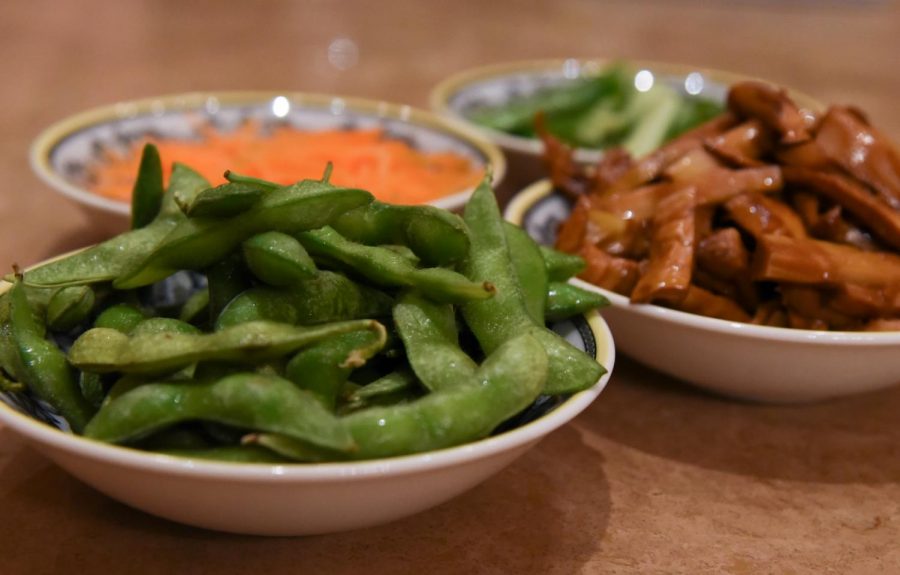Fasting traditions offer religious insight: Community members reveal stories behind fasts
A lunch prep for a vegetarian meal consists of stir fry carrots, bamboo shoots, tofu, cucumbers and boiled edamame. Some Buddhists choose to eat only vegetarian foods on the first and 15th days of the Chinese lunar calendar.
March 8, 2018
Religious fasting is the abstinence of certain foods or drinks during a specific time period. Followers of major religions such as Islam, Christianity, Buddhism, Judaism and Hinduism all have unique traditions behind and purposes for their fasting.
In Islam, Ramadan is a month of the Islamic calendar where Muslims observe a sunrise-to-sundown fasting period to commemorate the time the prophet Mohammed received the first revelations. In Christianity, a period of fasting for Catholics occurs during Lent, where some people refrain from meat consumption on Fridays. In Chinese Buddhism, some Buddhists choose to abstain from non-vegetarian foods for the first and the 15th day of each month in the Chinese lunar calendar.
Yom Kippur is the Jewish Day of Atonement, in which Jews repent by fasting. Jenna Sanders’ (12) Yom Kippur traditions are to fast for around 24 hours, from sundown to sundown. Prior to fasting, she eats a large dinner and attends night temple services. Afterward, she likes to eat bagels or kugels, a baked casserole commonly made from egg noodles or potato, to complete her fasts.
“One example is that people to choose to either drink water or not during the fast. I personally try not to drink water unless I feel like I’m fainting,” Jenna said. “Nowadays, there a lot of different types of Jews. Some just celebrate Hanukkah and identify as Jewish, but they do not go to temple services or practices, and there’s people going to temple services every Saturday, keep kosher and abide by every Jewish law.”
In Hinduism, there are different fasts for each god occurring on different auspicious days based on the Hindu lunar calendar. Some fasts require not consuming food or water for an entire day until a night ceremony, while others involve abstinence of non-vegetarian foods for certain days of the week. Harker parent Vinita Khanna honors the god Shiva by fasting during Mondays in July and August.
“[Fasting] calms me down, and restricting my diet really feels like a cleanse not just for my body, but also my mind,” she said. “I find it strengthens my discipline and willpower, which is something everybody needs.”
Khanna, unable to eat grains during her fast, prepares meals involving dairy products, fruits, nuts and a special flour made from fruits. Sabudana Khichdi, also known as Spicy Tapioca, is a dish that she consumes while fasting.
“My parents used to follow these traditions rather strictly, but life for me has gotten so busy that sometimes I only offer prayers and skip the fasting part.” she said. “People have started to stop believing in these traditions more and more, which is why it is uncommon now.”
Similar to Khanna, Prerana Acharyya (10) agrees that few Hindus are fasting now. Nevertheless, she believes that by following tradition, she can attain moksha or salvation, along with happiness and contentment.
“There are roughly 3.3 million Hindu gods, and a lot of people are unaware of this. Fasting traditions are specifically tailored to what you are trying to achieve and hence, what god you are praying to,” she said.
Despite the variation of fasting practices, one similar factor arises between each. Fasting is a method of devotion to a culture and religion.
“People think that following these traditions makes me orthodox and uneducated in a way. I wish people actually understood the real meaning to some of these rituals and weren’t just following them blindly. There is a lot to unpack in each of them,” Khanna said.
This piece was originally published in the pages of the Winged Post on March 6, 2018.


















![“[Building nerf blasters] became this outlet of creativity for me that hasn't been matched by anything else. The process [of] making a build complete to your desire is such a painstakingly difficult process, but I've had to learn from [the skills needed from] soldering to proper painting. There's so many different options for everything, if you think about it, it exists. The best part is [that] if it doesn't exist, you can build it yourself," Ishaan Parate said.](https://harkeraquila.com/wp-content/uploads/2022/08/DSC_8149-900x604.jpg)




![“When I came into high school, I was ready to be a follower. But DECA was a game changer for me. It helped me overcome my fear of public speaking, and it's played such a major role in who I've become today. To be able to successfully lead a chapter of 150 students, an officer team and be one of the upperclassmen I once really admired is something I'm [really] proud of,” Anvitha Tummala ('21) said.](https://harkeraquila.com/wp-content/uploads/2021/07/Screen-Shot-2021-07-25-at-9.50.05-AM-900x594.png)







![“I think getting up in the morning and having a sense of purpose [is exciting]. I think without a certain amount of drive, life is kind of obsolete and mundane, and I think having that every single day is what makes each day unique and kind of makes life exciting,” Neymika Jain (12) said.](https://harkeraquila.com/wp-content/uploads/2017/06/Screen-Shot-2017-06-03-at-4.54.16-PM.png)








![“My slogan is ‘slow feet, don’t eat, and I’m hungry.’ You need to run fast to get where you are–you aren't going to get those championships if you aren't fast,” Angel Cervantes (12) said. “I want to do well in school on my tests and in track and win championships for my team. I live by that, [and] I can do that anywhere: in the classroom or on the field.”](https://harkeraquila.com/wp-content/uploads/2018/06/DSC5146-900x601.jpg)
![“[Volleyball has] taught me how to fall correctly, and another thing it taught is that you don’t have to be the best at something to be good at it. If you just hit the ball in a smart way, then it still scores points and you’re good at it. You could be a background player and still make a much bigger impact on the team than you would think,” Anya Gert (’20) said.](https://harkeraquila.com/wp-content/uploads/2020/06/AnnaGert_JinTuan_HoHPhotoEdited-600x900.jpeg)

![“I'm not nearly there yet, but [my confidence has] definitely been getting better since I was pretty shy and timid coming into Harker my freshman year. I know that there's a lot of people that are really confident in what they do, and I really admire them. Everyone's so driven and that has really pushed me to kind of try to find my own place in high school and be more confident,” Alyssa Huang (’20) said.](https://harkeraquila.com/wp-content/uploads/2020/06/AlyssaHuang_EmilyChen_HoHPhoto-900x749.jpeg)











